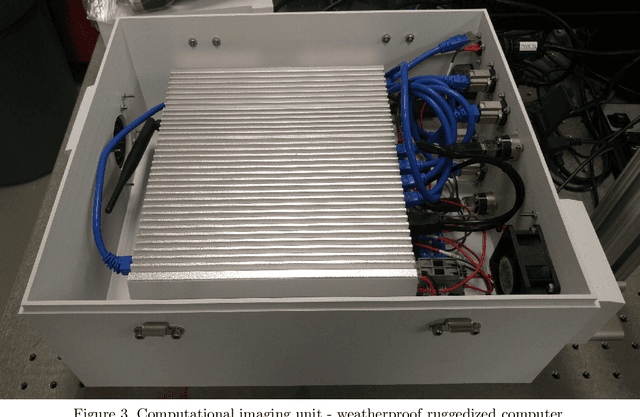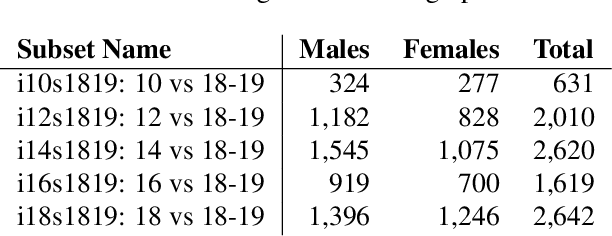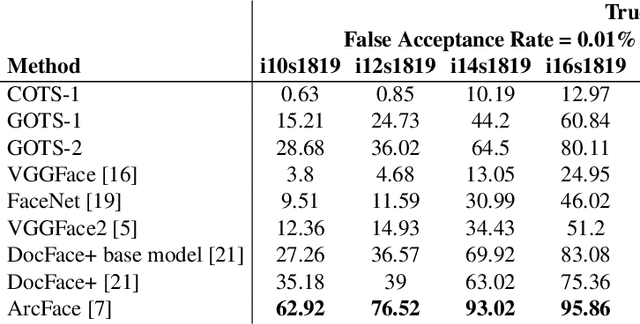Nisha Srinivas
Expanding Accurate Person Recognition to New Altitudes and Ranges: The BRIAR Dataset
Nov 03, 2022



Abstract:Face recognition technology has advanced significantly in recent years due largely to the availability of large and increasingly complex training datasets for use in deep learning models. These datasets, however, typically comprise images scraped from news sites or social media platforms and, therefore, have limited utility in more advanced security, forensics, and military applications. These applications require lower resolution, longer ranges, and elevated viewpoints. To meet these critical needs, we collected and curated the first and second subsets of a large multi-modal biometric dataset designed for use in the research and development (R&D) of biometric recognition technologies under extremely challenging conditions. Thus far, the dataset includes more than 350,000 still images and over 1,300 hours of video footage of approximately 1,000 subjects. To collect this data, we used Nikon DSLR cameras, a variety of commercial surveillance cameras, specialized long-rage R&D cameras, and Group 1 and Group 2 UAV platforms. The goal is to support the development of algorithms capable of accurately recognizing people at ranges up to 1,000 m and from high angles of elevation. These advances will include improvements to the state of the art in face recognition and will support new research in the area of whole-body recognition using methods based on gait and anthropometry. This paper describes methods used to collect and curate the dataset, and the dataset's characteristics at the current stage.
The Mertens Unrolled Network : A High Dynamic Range Fusion Neural Network for Through the Windshield Driver Recognition
Feb 27, 2020



Abstract:Face recognition of vehicle occupants through windshields in unconstrained environments poses a number of unique challenges ranging from glare, poor illumination, driver pose and motion blur. In this paper, we further develop the hardware and software components of a custom vehicle imaging system to better overcome these challenges. After the build out of a physical prototype system that performs High Dynamic Range (HDR) imaging, we collect a small dataset of through-windshield image captures of known drivers. We then re-formulate the classical Mertens-Kautz-Van Reeth HDR fusion algorithm as a pre-initialized neural network, which we name the Mertens Unrolled Network (MU-Net), for the purpose of fine-tuning the HDR output of through-windshield images. Reconstructed faces from this novel HDR method are then evaluated and compared against other traditional and experimental HDR methods in a pre-trained state-of-the-art (SOTA) facial recognition pipeline, verifying the efficacy of our approach.
Identity Document to Selfie Face Matching Across Adolescence
Dec 20, 2019



Abstract:Matching live images (``selfies'') to images from ID documents is a problem that can arise in various applications. A challenging instance of the problem arises when the face image on the ID document is from early adolescence and the live image is from later adolescence. We explore this problem using a private dataset called Chilean Young Adult (CHIYA) dataset, where we match live face images taken at age 18-19 to face images on ID documents created at ages 9 to 18. State-of-the-art deep learning face matchers (e.g., ArcFace) have relatively poor accuracy for document-to-selfie face matching. To achieve higher accuracy, we fine-tune the best available open-source model with triplet loss for a few-shot learning. Experiments show that our approach achieves higher accuracy than the DocFace+ model recently developed for this problem. Our fine-tuned model was able to improve the true acceptance rate for the most difficult (largest age span) subset from 62.92% to 96.67% at a false acceptance rate of 0.01%. Our fine-tuned model is available for use by other researchers.
 Add to Chrome
Add to Chrome Add to Firefox
Add to Firefox Add to Edge
Add to Edge